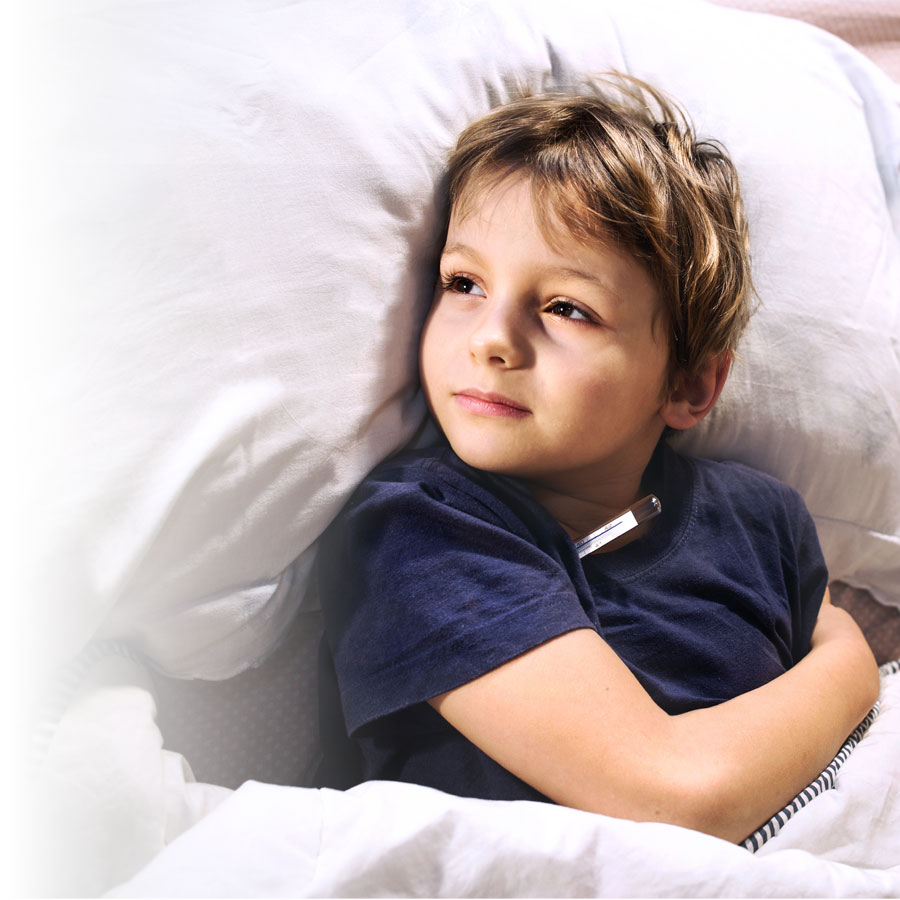Fever in children
A high fever is often a source of significant concern for parents. Moreover, it is a frequent reason for seeking medical advice at the pharmacy, in medical clinics, and at the emergency room. Being able to adequately understand, recognize, and manage fever is important for all parents who are concerned about doing the right thing.
Fever is not an illness, but rather a symptom. It is a way for the body to signal that something isn't right. The elevation of body temperature can also be viewed as a defence mechanism by the body.
Very often, fever manifests itself when a person has an infection such as a cold, the flu, an ear infection, pneumonia, etc. However, it can indicate other health problems. We usually speak of fever when the body temperature taken rectally exceeds 38.0°C.
Measuring temperature
To determine if a person has a fever, it is necessary to take his/her temperature in one of four areas of the body: rectum, ear, mouth or armpit. In children, the recommended method varies according to age.
As indicated in the table below, normal temperature ranges vary depending on the method used. If the temperature measured exceeds the highest value, the child is considered to have a fever.
Summary of recommended temperature-taking techniques for children
| Body part | Normal temperature range |
|---|---|
| Rectum | 36.6ºC – 38.0ºC (97.9ºF – 100.4ºF) |
| Ear | 35.8ºC – 38.0ºC (96.4ºF – 100.4ºF) |
| Mouth | 35.5ºC – 37.5ºC (95.9ºF – 99.5ºF) |
| Armpit | 34.7ºC – 37.3ºC (94.5ºF – 99.1ºF) |
For children under age two, the rectal method is recommended, as it is the most reliable one and is easier than the oral method. Another option for parents and children who do not like this method is to measure temperature under the armpit. This method may not be as accurate, but it does allows the detection of a fever. If the child has a fever, his/her temperature can then be taken rectally to obtain an accurate reading.
For children between the ages of two and five, the rectal method remains the best. The temperature can also be taken using the axillary (armpit) or the tympanic (ear) method to determine the presence of a fever.
After age five, children are usually able to keep a thermometer in their mouths. It should not be forgotten that oral temperature is easily influenced by the ingestion of food or drinks. The child must not eat or drink anything for at least 10 minutes before measuring temperature, and must keep his/her mouth firmly closed while the temperature is being taken.
The electronic thermometer (digital) is usually preferred to the mercury thermometer. Not only is it less fragile, but it is also easier to use and to read. Furthermore, mercury is toxic and harmful to the environment. The tip should be cleaned with soapy water and rinsed well after each use.
The auricular thermometer measures infrared emissions from the eardrum. This method is quick and comfortable, but is not recommended for children under age two. Additionally, it is less accurate. Speak to your pharmacist if you are considering to use it.
Here is a summary of recommendations according to age.
| Age | Recommended techniques | |
|---|---|---|
| 0 to 2 years | 1st choice | Rectum |
| 2nd choice | Armpit | |
| 2 to 5 years | 1st choice | Rectum |
| 2nd choice | Ear, armpit | |
| Over 5 years | 1st choice | Mouth |
| 2nd choice | Ear, armpit | |
What to do for fever
When a baby under the age of three months has a fever, it is always advisable to seek medical attention from a doctor. For a child over the age of three months, medical attention is required if the fever is high (exceeding 39ºC) or persists for more than 48 to 72 hours. Additionally, the presence of worrisome signs (vomiting, lethargy, confusion, dehydration, rash, etc.) justifies a doctor's visit immediately. When in doubt, it is better to see a doctor!
An over-the-counter medication to reduce fever should never be given to a child without first asking the advice of a healthcare professional, such as a pharmacist or a doctor. The appropriate medication must be chosen, as well as the dosage and frequency of use. This helps to promote the child's well-being and safety.
Speak to your pharmacist for additional information about fever and its treatment.

